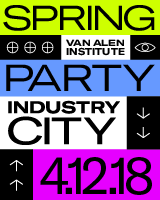
Today’s News - Thursday, February 15, 2018
EDITOR'S NOTE: Happy Birthday to us! February 18th marks our 16th ANNiversary (it was on a Monday in 2002)! Today marks our 3,353rd newsletter and 541st feature. To celebrate, tomorrow and Monday will be no-newsletter days - we'll be back Tuesday, February 20.
● ANN feature: Guy Geier brings us Nuts + Bolts #16: Branding can be a bit of a foreign concept for architecture firms. Here are some central takeaways from a firm rebranding itself after 40 years in practice.
● Salman parses what a truly disabled-accessible city would look like and how it would benefit, and offers her take on a few cities "undergoing a remarkable shift."
● Pedersen has a great Q&A with Saffron re: Philly's renaissance, affordable housing, and why Amazon's HQ2 might be good for the city: "Sure, Amazon is the evil empire, but they could be our evil empire!" (but, if the city wins, "I am confident that I will hate their architecture").
● Architectural theorist and mathematician Salingaros and philosopher François take a deep dive into "building with biophilia" and how "the way we shape our buildings, as Winston Churchill remarked, comes to shape us."
● Towering dreams in Tokyo: a 70-story skyscraper built with "wood accounting for 90% of the construction material" - and around $5+ billion (but will city code allow it?).
● McManus cheers a new venture between USGBC and DowDuPont in a "big LEED move" advising two cities to help them achieve LEED certification - the "initiative may create a process other communities can adopt and follow."
● How Ellsworth Kelly's "Austin," an almost church-like building to "rest your eyes, rest your mind," ended up alongside the Blanton Museum of Art in Austin.
● Agbo makes the case for a renaissance of traditional African architecture: "only a few design schools in Africa teach traditional architecture as a standalone course, and even that hasn't translated into much in terms of brick and mortar," and "city authorities have the moral obligation to demonstrate faith in it by commissioning some of its public architecture in this style."
● Sisson, meanwhile, parses "the architecture of Afrofuturism," and why film "'Black Panther' - and science fiction seen through a black cultural lens - has a lot to say about architecture, urbanism, and cities."
Weekend diversions:
● Modernism Week, "the ultimate celebration of midcentury architecture, design and culture," kicks off today in Palm Springs (we'll make it there one of these years!).
● The Architecture & Design Film Festival makes its Washington, DC, debut next week at the National Building Museum.
● Israeli architect Nili Portugali's film "And the Alley She Whitewashed in Light Blue" is "a deep intimate journey to the holy city of Tsefat - she feels that ancient mystic structures play a vital role in the quest for spirituality and salvation."
● One of Barragán's modernist masterpieces on the outskirts of Mexico City hosts "Sean Scully - San Cristóbal," the first exhibition at the equestrian and residential complex, "installed in a bold yet poetic dialogue with the architecture" (great pix).
● In London, "Building Images" at the Sto Werkstatt gallery "showcases the best of the best of the Architectural Photography Awards.
Page-turners:
● Betsky cheers Interboro's "The Arsenal of Exclusion & Inclusion," a "guide to modes of resistance, and thus an implied manifesto about how we can address architecture's complicity with social exclusion" - it should be on every architect's desk.
● Green parses "Design as Democracy: Techniques for Collective Creativity," an "impressive new book" that concludes "design is a political act" - though the editors "seem to disagree on the extent to which participatory design should be used to actively fight injustice."
● Wood says Rael's "richly illustrated 'Borderwall as Architecture: A Manifesto for the US-Mexico Boundary' couldn't come at a better time or with a greater sense of urgency."
● Moore revels in Agrawal's "Built: The Hidden Stories Behind our Structures": "Collaborative and unpretentious, she just very much likes what she does, and wants other people - especially girls and women - to know how good it is, too."
● An excerpt from Rattenbury's "The Wessex Project: Thomas Hardy, Architect" explains how the novelist and architect's project "was as radical in its time as 'Learning from Las Vegas' and 'Delirious New York' were in theirs."
● Schwab cheers architects Harpman and Specht's "Coffee Lids: Peel, Pinch, Pucker, Puncture" that "chronicles the decades-long history of an object you've probably never thought about in much detail - except to curse it when the inevitable drips occur."
| |






|
|
|
To subscribe to the free daily newsletter
click here
|
ANN feature: Guy Geier: Nuts + Bolts #16: What's in a Name? Branding can be a bit of a foreign concept to established (and even to newer) architecture firms. Here are some central takeaways from a firm rebranding itself after 40 years in practice.- ArchNewsNow.com |
Saba Salman: What would a truly disabled-accessible city look like? Most cities are utterly unfriendly to people with disabilities - but with almost one billion estimated to be urban-dwellers by 2050, a few cities are undergoing a remarkable shift: ...cities benefit from accessibility...Cities also miss out on economic gains: in the UK the “purple pound” is worth £212bn, and the accessible-tourism market an estimated £12bn. Some cities, however, are leading the way.- Guardian (UK) |
Martin C. Pedersen: Inga Saffron on Philadelphia’s Revival and Why Amazon Might Be Good For the City: Q&A with the architecture critic of the Philadelphia Inquirer re: the city's renaissance, the prospect of Amazon’s arrival, and the challenge of affordable and public housing..."Sure, Amazon is the evil empire, but they could be our evil empire! ...now having said all of that, if Amazon does choose Philadelphia, I am confident that I will hate their architecture."- Common Edge |
Damien François: Building with Biophilia: An Interview with Nikos Salingaros: Philosopher and high-altitude mountaineer sat down with architectural theorist and mathematician to discuss the way we shape our buildings, and how thereafter, as Winston Churchill remarked, they come to shape us. -- Christopher Alexander/"15 Fundamental Properties"; Salingaros/"Anti-Architecture and Deconstruction"/"Unified Architectural Theory"- Clarion Review |
Japanese company plans world's tallest wooden building: ...a 1,148-foot skyscraper in central Tokyo that will leave all previous wooden structures in its shade...W350 Project...70 stories...made of a combination of wood and steel, with wood accounting for 90% of the construction material....will require more than 6.5 million cubic feet of wood and the cost...estimated at Y600 billion (£4.2 billion)...Stringent Japanese regulations have previously made it difficult for designers to use wood... -- Sumitomo Forestry Co.; Nikken Sekkei [images]- Telegraph (UK) |
John McManus: DowDuPont's Big LEED Move: Venture with USGBC toward more sustainable cities and communities illustrates where companies are heading, fueled by purpose-driven profitability: ...quarterly-results-oriented profitability without purpose, without mindful contribution to efforts to improve human lives and the life of the earth itself, won't cut it any more...[venture] will advise two cities...to help them achieve LEED certification...initiative may create a process other communities can adopt and follow. -- U.S. Green Building Council- Builder magazine |
How Ellsworth Kelly’s Final, Immersive Work Ended Up in Austin, Texas: ..."he particularly loved Romanesque and Cistercian medieval architecture"...his final and most monumental work: "Austin", a 2,715-square-foot building constructed alongside the Blanton Museum of Art...he envisaged [it] as someplace to "rest your eyes, rest your mind"...From the outside, "Austin" is dwarfed by the Brutalist academic buildings that ring it. But the space seems to expand as you enter... [images]- Artsy magazine |
Mathias Agbo, Jr.: Making a Case for the Renaissance of Traditional African Architecture: The continent needs to reclaim its architectural heritage: ...only a few design schools in Africa teach traditional architecture as a standalone course and even that hasn’t translated into much in terms of brick and mortar...city authorities have the moral obligation to not only write a new category of building codes to cover this indigenous architecture, but must demonstrate faith in it by commissioning some of its public architecture in this style. -- Demas Nwoko; Diébédo Francis Kéré- Common Edge |
Patrick Sisson: Space is the Place: The architecture of Afrofuturism: Why "Black Panther" - and science fiction seen through a black cultural lens - has a lot to say about architecture, urbanism, and cities: ...There are numerous ways Afrofuturism’s themes of imagination, liberation, technology, and mysticism reflect on the built world and strive to create alternate environments...If science fiction is a means of discussing present-day anxieties and issues via the future, then it only follows that the architecture and design of our fantasies can make a massive impact on how we see our present day.- Curbed |
Modernism Week: The Ultimate Celebration of Midcentury Architecture, Design and Culture, Palm Springs, California, February 15-25: ...annual celebration...features more than 350 events including the Modernism Show & Sale...Premier Double Decker Architectural Bus Tours, Architecture Design Art Film Series, nightly parties and live music, walking and bike tours...classic cars...a vintage travel trailer exhibition, and more.- Modernism Week |
National Building Museum Hosts D.C.'s First Architecture & Design Film Festival, February 22-25: Featuring more than 25 films, the ADFF: D.C. will focus on life and work of architects, designers, and activists including Bjarke Ingels, Rem Koolhaas, Frank Gehry, Richard Neutra, and Jane Jacobs.- Architect Magazine |
Women directors’ films unveil journey into quest of gender equality and profound universal insight: Israeli film maker Nili Portugali takes us on a deep intimate journey to the holy city of Tsefat. Being an architect, she feels that ancient mystic structures play a vital role in the quest for spirituality and salvation. "And the Alley She Whitewashed in Light Blue" is a journey that unfolds gradually...- Mumbai International Film Festival (MIFF) |
The abstract artist taking on Luis Barragán’s famed modernist estate: ...at Cuadra San Cristóbal, one of Barragán’s modernist masterpieces, on the outskirts of Mexico City. The site-specific exhibition, entitled "Sean Scully - San Cristóbal"...the first to take place at the equestrian and residential complex...installed in a bold yet poetic dialogue with the architecture; thru March 24 [images]- Wallpaper* |
Sto Werkstatt gallery, London, celebrates Architectural Photography Awards in a show designed by Mobile Studio Architects: "Building Images" highlights work by some of the best of the year’s architectural photographers...a total of 20 strong contestants...The 2018 winning image [by] Terrence Zhang...features an empty swimming pool on the new campus of Tianjin University, designed by Atelier Li Xinggang.; thru April 27 [images]- Wallpaper* |
Aaron Betsky: All the Things We Leave Out: A new book by Interboro catalogs techniques of exclusion, and some of inclusion.: "The Arsenal of Exclusion & Inclusion" by Tobias Armborst, Daniel D’Oca, and Georgeen Theodore...a guide to modes of resistance, and thus an implied manifesto about how we can address architecture’s complicity with social exclusion. The book is as important for architects to have on their desks as any building code...I hope [they follow] up...with one that catalogs more techniques of subversion, trespassing, and appropriation.- Architect Magazine |
Jared Green: Participatory Design Must Evolve: Participatory design is “hands-on democracy in action,” argue the editors of the impressive new book "Design as Democracy: Techniques for Collective Creativity"...The editors [landscape architects and professors] conclude that “design is a political act"...But they seem to disagree on the extent to which participatory design should be used to actively fight injustice. -- David de la Pena; Diane Jones Allen; Randolph T. Hester, Jr,; Jeffrey Hou; Laura J. Lawson; Marcia J. McNally- The Dirt/American Society of Landscape Architects (ASLA) |
Marty Wood: Bordering on Absurd: How architects can engage critically with the idea of the border wall: "Borderwall as Architecture: A Manifesto for the US-Mexico Boundary" by Ronald Rael is a collection of proposals, counterproposals, speculations, and research findings that encourage a critical engagement with border conditions....[It] couldn’t come at a better time or with a greater sense of urgency...richly illustrated...proves to be a guide to outside-the-box thinking spatially as well as politically about the border.- The Architect's Newspaper |
Rowan Moore: Roma Agrawal: ‘Structural engineers are unsung heroes’: The Shard engineer has long been fascinated by the technical ingenuity of design. Now she wants to help us see the built environment with similar wonder: Her sense that engineering is undervalued has motivated her to proselytise for it..."Built: The Hidden Stories Behind our Structures"...tells the human stories behind great structures...Collaborative and unpretentious, she just very much likes what she does, and wants other people - especially girls and women - to know how good it is, too. -- Renzo Piano; WSP; Aecom- Observer (UK) |
Kester Rattenbury: The Invention of Wessex: The novelist and architect Thomas Hardy saw rural England through an experimental, modern frame. His Wessex Project was as radical in its time as "Learning from Las Vegas" and "Delirious New York" were in theirs. (adapted from "The Wessex Project: Thomas Hardy, Architect") [images]- Places Journal |
Katharine Schwab: The Secret World Of Coffee Cup Lid Design: These two architects have collected hundreds of coffee cup lids - and in a new book, they celebrate this fascinating “invisible” design: Design is supposed to solve problem...but the coffee cup lid is one of those odd objects that has never been perfected..."Coffee Lids: Peel, Pinch, Pucker, Puncture" by architects Louise Harpman and Scott Specht chronicles the decades-long history of an object you’ve probably never thought about in much detail - except to curse it when the inevitable drips occur. [images]- Fast Company / Co.Design |
ANN feature: Norman Weinstein: Educating Future Architects to Think Like Curious Clients: Expanding architectural education to include more about client consciousness is a key to enriching the profession.- ArchNewsNow.com |
|
|
Note: Pages will open in a new browser window.
External news links are not endorsed by ArchNewsNow.com.
Free registration may be required on some sites.
Some pages may expire after a few days.
© 2018 ArchNewsNow.com


